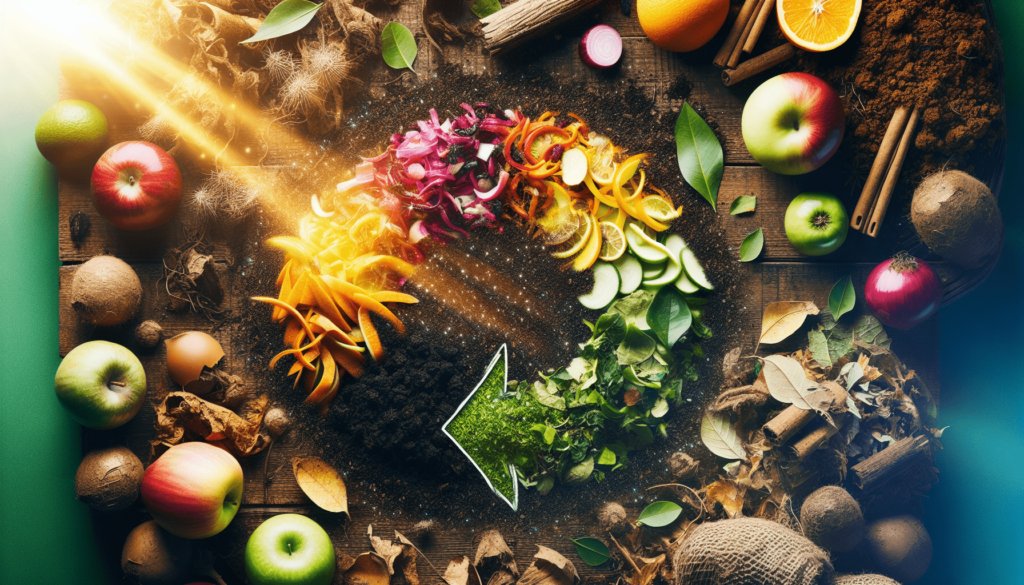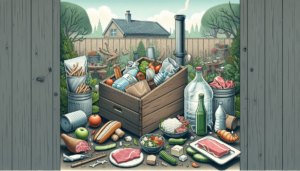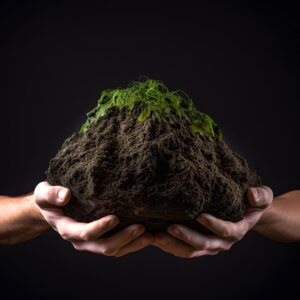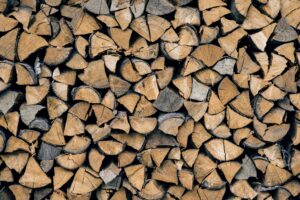Looking to reduce waste and nourish your garden? We’ve got you covered! In this article, we’ll share all the tips and tricks you need to know to start your very own compost pile right at home. Whether you’re a gardening enthusiast or simply looking for an eco-friendly way to dispose of your kitchen scraps, we’ll guide you on this composting journey. From choosing the right location and materials to maintaining the optimal balance of organic matter, we’ll ensure that you have all the information you need to kick-start your composting adventure. So let’s grab our gardening gloves and get ready to turn our kitchen waste into nutrient-rich soil!

Choosing a Location
Composting is a rewarding and sustainable way to reduce waste and improve the health of your garden. The first step in starting a compost pile at home is to find a suitable spot in your yard. Look for an area that is easily accessible and provides enough space for your compost pile to decompose effectively.
Consider the amount of sunlight and shade the chosen location receives. While some heat from the sun is beneficial for the decomposition process, excessive sunlight can dry out the compost pile. On the other hand, a completely shaded spot may impede the decomposition process.
Next, ensure easy access to water. Composting requires a certain level of moisture for the organic materials to break down properly. Make sure your chosen spot is close to a water source, such as a garden hose, to make watering your compost pile more convenient.
Lastly, check for airflow and drainage in the chosen location. Good airflow is crucial for the compost pile to receive oxygen, which aids in decomposition. Look for an area with decent air circulation to avoid the buildup of unpleasant odors. Additionally, ensure that the location has adequate drainage to prevent the compost pile from becoming waterlogged.
Selecting a Compost Bin
Once you have chosen a suitable location, it’s time to select a compost bin. There are two main options to consider: a DIY (do-it-yourself) bin or a purchased bin.
If you enjoy hands-on projects and have some spare time, building your own compost bin can be a fulfilling experience. It allows you to customize the size and design according to your needs. Many DIY compost bins can be made using simple materials, such as pallets or wire mesh. However, keep in mind that constructing a compost bin from scratch requires a certain level of skill and effort.
On the other hand, if you prefer convenience and ready-to-use solutions, purchasing a compost bin is a great option. There are various types and sizes available in the market, ranging from plastic bins to tumblers and rotating bins. Consider the size and capacity of the bin, ensuring it can accommodate the amount of organic waste you generate.
When selecting a compost bin, look for features that promote aeration and drainage. Proper aeration is essential for the decomposition process, as it allows oxygen to reach the organic materials. Look for bins with ventilation holes or designs that allow for good airflow. Additionally, choose a bin with drainage features to prevent excess moisture build-up.
Opt for compost bins made from durable and weather-resistant materials. Since composting is a long-term process, it’s important to invest in a bin that can withstand outdoor conditions. Consider materials such as recycled plastic, metal, or wood that are known for their durability and ability to withstand the elements.

Gathering Compostable Materials
The success of your compost pile depends on the quality and variety of compostable materials you add. It’s important to identify the different types of materials that can be composted.
Green materials, also known as nitrogen-rich materials, provide essential nutrients for the compost pile. These include kitchen scraps like fruit peels, vegetable trimmings, and coffee grounds. Coffee filters made from unbleached paper can also be added. Remember to avoid meat, dairy, and oily foods, as they can attract pests and lead to unpleasant odors.
Brown materials, also called carbon-rich materials, help create a well-balanced compost pile. These include items such as dry leaves, straw, sawdust, and wood chips. Yard waste like grass clippings and small branches can also be added. Paper and cardboard, in small amounts, can be included. However, avoid glossy or colored paper, as they may contain harmful chemicals.
It’s important to maintain a balance between green and brown materials in your compost pile. Aim for a ratio of roughly 3 parts brown materials to 1 part green materials. This balance ensures proper decomposition and prevents odors or other issues.
Layering the Compost Pile
Layering your compost pile is an effective way to create the ideal conditions for decomposition. Start by adding a layer of twigs or straw at the bottom of the pile. This layer allows for airflow from the bottom and helps prevent the pile from becoming compacted.
Next, add a layer of brown materials. This layer provides a source of carbon and helps absorb excess moisture. Make sure to evenly distribute the brown materials over the twigs or straw layer.
Follow the brown layer with a layer of green materials. This layer adds nitrogen to the compost pile and helps activate the decomposition process. Again, make sure to distribute the green materials evenly.
Continue layering the compost pile, alternating between brown and green materials, until you reach the desired height. Aim for a pile that is at least 3 feet high and 3 feet wide. It’s important to create layers rather than dumping all the materials at once to ensure proper airflow and decomposition.

Moistening the Compost Pile
Proper moisture is essential for the decomposition of organic materials in your compost pile. Without enough moisture, the composting process can slow down or come to a halt. Conversely, too much moisture can lead to a slimy and anaerobic environment.
To moisten your compost pile, sprinkle water evenly over the materials. Use a garden hose with a gentle spray or a watering can to avoid over-saturating the pile. The goal is to achieve a damp but not soggy consistency, similar to a wrung-out sponge.
It’s important to check the moisture levels regularly and adjust as needed. If the pile feels too dry, add more water. If it feels too wet, add additional brown materials to absorb the excess moisture. Maintaining the right moisture balance will help facilitate the decomposition process and prevent any unpleasant odors.
Turning the Compost Pile
Regularly turning your compost pile is crucial for aeration and mixing of materials. This process helps speed up decomposition, ensures even distribution of nutrients, and prevents the pile from becoming compacted.
To turn the compost pile, use a pitchfork or shovel to carefully lift and mix the materials. Start by transferring the outer layers to the center of the pile. This allows the materials that were previously at the center to receive oxygen and aids in decomposition.
Turning the compost pile every few weeks is generally recommended. However, you may need to adjust the frequency based on factors such as temperature, moisture levels, and the size of your pile. Monitor the temperature of the compost pile regularly using a compost thermometer. Ideally, the temperature should range between 120 to 150 degrees Fahrenheit for efficient decomposition. Adjust the turning frequency accordingly to maintain this temperature range.

Managing the Compost Pile
Proper management of your compost pile is essential to ensure a healthy and productive composting process. Here are some key considerations to keep in mind:
Monitor and adjust moisture levels: Regularly check the moisture levels of your compost pile and make adjustments as needed. Remember to maintain a damp but not overly saturated environment.
Maintain the carbon-to-nitrogen ratio: To promote efficient decomposition, it’s important to maintain a proper balance of carbon (brown materials) and nitrogen (green materials). Adjust the ratio as needed by adding more of either type of material.
Avoid adding diseased plants or weeds with seeds: It’s best to avoid adding plants that are diseased or infested with pests. Similarly, weeds with seeds can make their way back into your garden, so dispose of them separately.
Promote decomposition with occasional turning: In addition to regular turning, occasional mixing or aerating of the compost pile can further promote decomposition. This can be done by using a garden fork or compost aerator.
Add compost activators if needed: Compost activators, such as compost starters or accelerators, can be beneficial if you want to speed up the decomposition process. These products contain microorganisms that help break down organic materials more efficiently.
Troubleshooting Compost Issues
Sometimes, issues can arise with your compost pile. Here are some common problems and how to address them:
Identify and address foul odors: If your compost pile has a foul smell, it may indicate that the pile is too wet or lacking airflow. To address this, turn the pile more frequently and add brown materials to absorb excess moisture. Avoid adding meat, dairy, or oily foods, as they can contribute to unpleasant odors.
Adjust moisture levels to prevent dry or wet compost: If your compost pile is too dry, add water to increase moisture content. If it’s too wet, add more brown materials to absorb the excess moisture. Remember to maintain a balanced moisture level to create an ideal environment for decomposition.
Turn the pile more frequently if it’s not decomposing: If you notice that your compost pile is not decomposing as quickly as expected, it may be due to insufficient aeration or an improper carbon-to-nitrogen ratio. Increase the frequency of turning to provide better aeration, and adjust the ratio of brown to green materials.
Manage pests and rodents with proper bin maintenance: If you encounter issues with pests or rodents in your compost bin, it’s important to take proper measures to manage them. Avoid adding food scraps that can attract pests, and make sure your compost bin is sealed and secure. Additionally, regularly turning the pile can help deter pests and discourage their presence.
Harvesting and Using Compost
Once your compost has fully decomposed and reached a dark, crumbly texture with an earthy smell, it’s ready to be harvested and used in your garden. Here’s how to go about it:
Allow compost to mature for 6-12 months: Depending on the materials used and the conditions of your compost pile, the composting process can take anywhere from 6 to 12 months. Patience is key to allow the beneficial microbes to break down the organic matter fully.
Check for desired texture and smell: When your compost is mature, it should have a dark, crumbly texture that resembles soil. It should also have a pleasant, earthy smell. If the compost still has visible organic materials or an unpleasant odor, it may need more time to fully decompose.
Screen or sift the compost: Before using the compost, you may want to remove any large debris or undecomposed materials. This can be done by passing the compost through a screen or a fine mesh to create a finer and smoother texture.
Apply compost to garden beds or potted plants: Spread the finished compost evenly over your garden beds or mix it into potting soil for potted plants. The compost will enrich the soil with nutrients and beneficial microbes, promoting healthy plant growth.
Store excess compost: If you have more compost than you need, store the excess in a covered container for later use. Make sure the container is airtight to prevent moisture loss.
Benefits of Home Composting
Home composting offers a host of benefits for both the environment and your garden. Here are a few key advantages:
Reduces waste sent to landfills: Composting diverts organic waste from landfills, where it would otherwise decompose anaerobically and contribute to greenhouse gas emissions. By composting at home, you are helping to reduce the burden on landfill systems and minimize your carbon footprint.
Enriches soil with nutrients and beneficial microbes: Compost is a natural fertilizer and soil amendment that enriches the soil with essential nutrients such as nitrogen, phosphorus, and potassium. It also introduces beneficial microorganisms that improve soil health and help plants thrive.
Improves soil structure and water retention: The addition of compost to soil improves its structure, making it more crumbly and easier to work with. It increases the soil’s water-holding capacity, reducing the need for frequent watering and helping plants withstand dry periods.
Reduces the need for synthetic fertilizers: Compost provides a sustainable alternative to synthetic fertilizers by supplying plants with the necessary nutrients in a slow-release, organic form. Using compost alongside other organic gardening practices can significantly reduce the reliance on chemical fertilizers.
Promotes sustainable gardening practices: Home composting is a key component of sustainable gardening. By recycling organic waste and producing your own nutrient-rich compost, you are actively engaging in eco-friendly practices that support a healthy and thriving ecosystem.
In conclusion, starting a compost pile at home is a simple and fulfilling way to reduce waste, improve soil health, and promote sustainable gardening. By choosing a suitable location, selecting the right compost bin, gathering the appropriate materials, layering and moistening the pile, and managing the composting process, you can create rich and nutrient-filled compost to enhance the health and productivity of your garden. Embrace the practice of home composting and reap the benefits of this environmentally friendly and rewarding endeavor.




